| History of The Australian Commonwealth Specialists' Catalogue |
 |
 |
 |
 |
 |
 |
 |
 |
 |
 |
 |
 |
 |
 |
 |
 |
 |
| History of The Australian Commonwealth Specialists' Catalogue |
 |
 |
 |
 |
 |
 |
 |
 |
 |
 |
 |
 |
 |
 |
 |
 |
 |
Miscellaneous Information |
|||||||||||||||||||||||||||||||||||||||||||||||||||||||||||||||||||||||||||||||||||||||||||||||||||||||||||||||||||||||||||||||||||||||||
|
Watermarks Six different watermark papers, as well as unwatermarked paper, were used for the Kangaroo & KGV Head stamps. ACSC designates the watermarked papers as Stamp type 1 to 6. Watermarks are formed in the wet pulp stage of papermaking by pressure rollers, which results in thinning of the paper. It is this thinning that is apparent under a backlight. The Kangaroo stamps use the following watermarks:
The KGV Head stamps use the following watermarks:
Paper Stamp types Apart from watermarked and unwatermarked papers, there are different stamp paper Stamp types . Thick and Thin Paper Thick paper is a surfaced paper and the watermark is quite often difficult to see. Thin paper is almost transparent, by comparison, and the watermark is clearly visible. With particularly thin papers, the stamp design can clearly be seen from the reverse side of the stamp. Brusden-White has defined "thin paper" as being less than 0.07mm thick. Smooth Paper Smooth paper is a coated paper traditionally used for the printing of postage stamps. Rough Paper Rough paper is an uncoated paper that was used when supplies of coated paper were interrupted during WWI. A rough paper stamp may look mottled in appearance (due to higher ink absorption). The stamp surface may feel slightly rougher to touch, compared to surfaced paper; and due to the greater absorption of ink, the shade may be slightly darker. Helecon Paper Helecon is a trade name of a luminescent zinc-sulphide chemical. It reacts to Ultra Violet light and fluoresces a bright orange red. It was applied to all Australian postage stamps since 1965, with two exceptions: a trial run of the 1963 11d. Bandicoot stamp on Helecon paper; and 1965 5d. QEII definitive stamp was printed on surplus non-Helecon paper by mixing Helecon in the printing ink. Cream and White Paper In mid 1964 a Wiggins Teape cream watermarked paper replaced the Harrison white watermarked paper. The 1964 5/- Cattle stamp was the first to be printed using both papers, with the some stamps of the Navigator series also being printed in both papers. Dies A Die is the medium (usually metal) on which the stamp's design is first engraved. This original die is designated Die 1. If it becomes necessary (due to either damage or wear) to alter the die, later versions are designated Die 2, Die 3, etc. Minor repairs (for example) can be designated as Die 2A & Die 2B. Printing plates (often multiple plates) are prepared from these dies.
¼ Perforations The earliest Australian Colonial Stamps were printed and issued Imperforate, with individual stamps being cut by hand at local post offices. The next stage was Rouletting the stamps as part of the printing process, by the use of a toothed wheel or disk. This method involved either piercing or making small cuts in the paper. The final stage was Perforation of the paper, where paper was punched out to form a circular hole. The early Australian stamps were perforated using either a single line perforating machine but more usually by a comb perforator. The Kangaroo stamps all used a Perf. 11¾ comb, using the same spacing vertically and horizontally. Some King George V Head stamps had Single Line Perforations but were mainly Comb perforations. The engraved heads were Single Line Perf. 11 with others being Single Line Perf. 14.2. The majority however were either Perf. 14¼ x 14 comb or Perf. 13½ x 12½ comb. Perforations are measured by the number of holes per two centimetre. Perforation gauges allow measurement in ¼ hole increments, while some publications display perforations to the nearest ½ hole increments. Reprint Indicators From October 1989 Australia Post identified stamp reprints by the use of small Koala and / or Kangaroo emblem in the sheet selvedge (margin). These logos were introduced to allow easy identification of reprints. Initially the emblems were printed adjacent to every second row, but were soon printed next to every row. The original printing has no marginal indicators. The reprints are identified as follows:
Printers From 1850 to 1901, Australian postal services were under the control of the six independent British Crown Colonies (now States). This continued as an informal arrangement until the first official Commonwealth stamps were issued in 1913. Between 1913 and 1977 all stamps were printed in Melbourne, with the exception of two of the 1956 Olympic Games stamps (the 1/- & 2/- values), and the 1962 British Empire & Commonwealth Games stamp set. Stamp Printing Authorities 1909 The Stamp Printing Branch of the Commonwealth Treasury Department was established, as the Commonwealth Stamp Printer. 1918 The Stamp Printing Branch was abolished and printing of Commonwealth Postage Stamps became the responsibility of the Note Printing Branch of the Treasury Department, as the Australian Note and Stamp Printer. 1924 The Note and Stamp Printing Branch was transferred to the control of the Commonwealth Bank. 1959 The Note and Stamp Printing Branch was abolished and a new Note Printing Branch under control of the Reserve Bank was established. 1969 The Note Printing Branch of the Reserve Bank was re-organised, with stamp printing & production now carried out by the Printing Division of the Note Issue Department. 1977 Since 1977 a number of private security companies have been contracted to print Australian Commonwealth Stamps. A comprehensive article 'Modern Australian Stamp Printers' by Richard Breckon can be viewed HERE. 1981 The last stamp printed at the Note Printing Branch was the 50th anniversary of APEX commemorative. The Official Stamp Printers J. B. Cooke. 1913-1918 John Bradley Cooke was the South Australian Government Stamp Printer from 1881, and is credited with an improved stamp perforation system. In 1913 he took up the position of Commonwealth Stamp Printer. He retired in May 1918. T. S. Harrison. 1918-1926 Thomas Samuel Harrison came over to Australia from London in September 1912, having previously worked for Waterlow & Sons. (A firm of English engravers and printers, founded in 1810 and acquired by De La Rue in 1961). He was immediately appointed as Australia's first official Banknote Printer and under his guidance a production facility was established at Kings Warehouse near the docks in West Melbourne. In 1918, with the amalgamated of the Stamp Printing Branch into the Note Printing Branch, he was appointed the Australian Note and Stamp Printer. He retired circa March 1926. A. J. Mullett. 1926-1927 Albert James Mullett was Victorian Government Printer from 1914 to 1924, beginning as an apprentice. Approximately one year after his retirement he was appointed acting Commonwealth Note and Stamp Printer (February 1926 to June 1927) while a replacement for Harrison could be found. He passed away in October 1938, age 74. John Ash. 1927-1940 John Ash was born on 17 May 1872 at Perth, Scotland. Ash had been Printing Manager of De La Rue & Co., London before coming to Australia. He joined the Commonwealth Bank on 21 March 1927 as the Australian Note and Stamp Printer. He had a genuine interest in stamp quality and was responsible for the changeover from letterpress to recess-printing in the early 1930s. He retired on 20 April 1940 as General Manager of the Note Printing Branch. He passed away on 28 November 1947, age 75. W. C. G. McCracken, O.B.E. 1940-1963 William Clifford Gordon McCracken was born on 22 March 1898 at Fitzroy, Victoria. W. H. Wilcock, C.B.E. 1963-1969 William Howard Wilcock was born at Ballarat, Victoria on 21 December 1904. He joined the Commonwealth bank on 1 March 1921, and appointed General Manager, Note Printing Branch Melbourne, on 21 April 1962. He was in office during a period of great technical innovation. He also saw the changeover to decimal currency prior to his retirement on 14 November 1969. It is reported that he passed away 17 September 1999. Monograms and Imprints The various Commonwealth Stamp Printers included marginal marking, in the form of Monograms or Imprints:
Colour Groups Stamp colours fall into the following groups or classes.  Primary Colours: Red, Blue, Yellow.
Primary Colours: Red, Blue, Yellow.Secondary Colours: Violet, Green, Orange. Adjacent Colours: e.g. Red, Orangey Red, Orange-Red, Red-Orange, Reddish Orange, Orange, Yellowish Orange, Yellow-Orange, Orange-Yellow, etc. (Also called analogous colours.) Grey Group: Greys are intermediate colours between White and Black. (Greys are called neutral or achromatic grey when no other colour is added.) Brown Group: A composite colour group created from reds, yellows, and black. The following illustrates the shades around the RBG colour spectrum in 10° segments: Naming Colours and Shades Colours The naming convention used in this website follows the generally accepted rule that if a name is composed of two colours, it is hyphenated (e.g. Blue-Green, Yellow-Green, etc.), with the last named colour being the prominent colour. Colours with a special name (comprising two words) are not hyphenated (e.g. Cyprus Green, Moss Green, etc.). Shades Where a colour is prefixed by a shade modifier (e.g. Bright, Dark, Deep, Dull, Intense, Light, Milky, Pale, Very) or by a colour modifier (e.g. Reddish, Bluish, Yellowish, etc.) it is not hyphenated (e.g. Dark Green, Bluish Green, Very Deep Yellow-Brown, Pale Yellowish Green, etc.). Shade modifiers can be interpreted as follows: Light / Dark.....refers to the amount of white or black in the colour. Pale / Deep.....refers to the "strength" of the ink and/or the amount of ink applied during printing, i.e. dry ink. Dull / Bright.....refers to the general appearance of the stamp, where "dull" could be described as "flat & lifeless" and "bright" as "fresh almost vivid". Aniline.....refers to a colour produced with a water soluble (coal-tar) dye base, that runs when wetted and fluoresces strongly under UV light. Aniline stamps can display a distinct brightness of colour on the face, with the colour showing through to the back of the stamp. Stanley Gibbons' Shades The leading authority for the naming of shade colours for Commonwealth stamps is arguably Stanley Gibbons, UK. They were established in 1856, just 14 years after the issue of the world's first adhesive postage stamp, the British "Penny Black". See Here
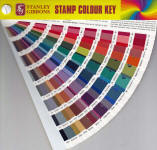 In
1970, Stanley Gibbons issued a Stamp Colour Key (Item No. 2530), that contains 100 named colours. In
1970, Stanley Gibbons issued a Stamp Colour Key (Item No. 2530), that contains 100 named colours.
An expanded Colour Key was issued in 1986 containing 200 colours. This was reissued in 2001 and still contained 200 colours A later Stanley Gibbons guide (shown above) was an undated Stamp Colour Key (still with the Item No. 2530 reference), containing 200 named colour chips. Stanley Gibbons has released an unchanged version of this colour key as item R2530. A list of these shades can be viewed here. Brusden White's Shades PRE-DECIMAL SHADES The shade names used in the Pre-Decimal ACSC are not related to the SG shades. The names are a more natural or instinctive colour description of adjacent colours (see the Colour Groups above), together with the following unique names: Buff, Carmine, Chestnut, Chocolate, Chrome, Crimson, Cyprus Green, Damson, Emerald, Indigo, Lemon, Lilac, Lime, Maroon, Moss Green, Olive, Pink, Plum, Purple, Rose, Rosine, Russet, Salmon, Scarlet, Sea Green, Silver, Slate, Terra Cotta, Turquoise, Ultramarine. A full list of the shade names used by Brusden-White in their Kangaroo & KGV catalogues can be viewed here. DECIMAL SHADES The decimal shade names are based on the latest Stanley Gibbons Colour Key containing 200 named colour shades. A list of those shades can be viewed here. KGV 1d. Red Shades The shades of the 1d. Red King George V heads is arguably the most difficult and confusing when collecting stamp shades. The variation in shades resulted from the difficulty in acquiring consistent supplies of suitable pigments during the war years. In 1932 a specialist committee was set up to form a workable shade listing. This committee comprised the following leading experts: Appleby, Colenso-Blogg, Hatcher, Johnson, Orlo-Smith, Purves, and Rosenblum. The basis for this committee's work was Colenso Blogg's 1930 list of 1d Red Shades. It comprises smooth paper shades Z 1 to Z 273, rough paper shades Z 301 to Z 375, War Saving Stamp Paper shades Z 401 to Z 406, Cook Large Multiple watermark shades Z 407 to Z 412, and Harrison Large Multiple watermark shades Z 413 to Z 422. A full listing of these shades can be viewed here. This committee came up with a recommended list of "G" prefixed Shade Groups for the Georgian Issues. These were listed in Orlo-Smiths 1933 Third Edition Supplement. The "G" numbers for the 1d. Red shades are still in use today, and are listed in the "KGV 1d. Red - "G" Shades" section of this website here. These "G" numbers represented a "..... full list of major colours, and, after each colour, a list of the chief variants of shade in that class when they exist". Note the qualifying 'major' and 'chief', clearly indicating that numerous more shades exist within each shade group. For those requiring a simplified method of collecting, Orlo-Smith suggested that ....." the Penny red arrange themselves in the following groups":
1914 - Carmine-Reds 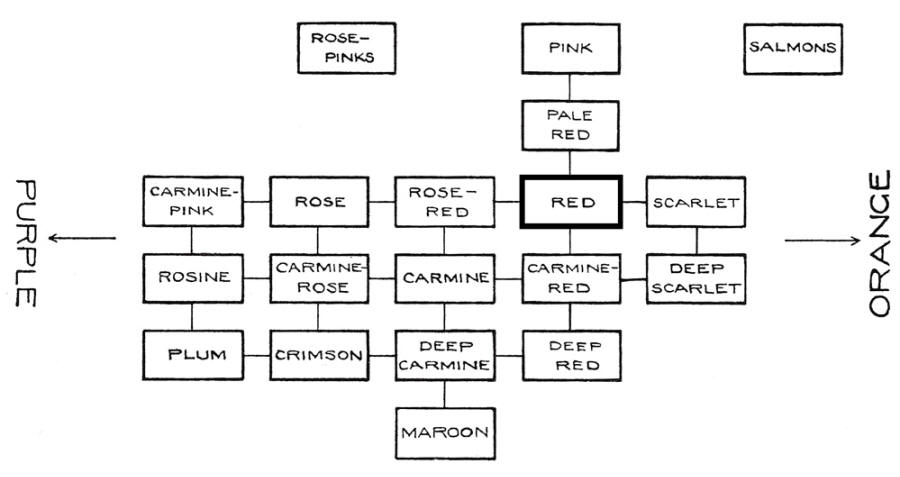 State Stamp Catalogues Brusden White Catalogues  The
1988 Loose-Leaf Catalogue released by Brusden-White did not include Section A. The
1990 update added the missing Section A, entitled "Australian States". The
1988 Loose-Leaf Catalogue released by Brusden-White did not include Section A. The
1990 update added the missing Section A, entitled "Australian States". A booklet entitled "Australian Colonies" (based on the 1990 update) was later published by Brusden-White. The Brusden-White's Australian Colonies / States is a simplified listing when compared to the specialist Stanley Gibbons' Catalogue (see below); but is more detailed than the Stanley Gibbons' Simplified catalogue and the Seven Seas Stamp Catalogues (see below). 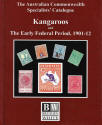
 The 2004 Kangaroos edition includes State stamps covering the Early Federal Period from 1901 to 1912.
This is a highly specialised listing of the stamps of this short period.
The 2004 Kangaroos edition includes State stamps covering the Early Federal Period from 1901 to 1912.
This is a highly specialised listing of the stamps of this short period.In 2023 the Second Edition of the Australian States Federal Period, 1901-1912 was issued. It is a full colour A4 size softbound edition. Stanley Gibbons Catalogues 

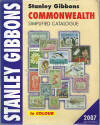 Stanley Gibbons is the de-facto reference standard for Australia's Colonial State stamps.
Stanley Gibbons is the de-facto reference standard for Australia's Colonial State stamps. A detailed specialist listing is part of the Stanley Gibbons "Australia Stamp Catalogue", as well as their "Commonwealth & British Empire Stamps 1840-1970". A simplified listing is available in Stanley Gibbons "Commonwealth Simplified Catalogue". The Stamp types and stamp reference numbers are identical to the specialist editions. Seven Seas Catalogues 
 Seven Seas Stamps includes State stamps in their "Australasian Stamp Catalogue", and their published "The Australian Colonies Stamp Catalogue",
which is somewhat more detailed than their general catalogue.
Seven Seas Stamps includes State stamps in their "Australasian Stamp Catalogue", and their published "The Australian Colonies Stamp Catalogue",
which is somewhat more detailed than their general catalogue. Both catalogues use common Stamp numbers but use different Stamp type numbers. These catalogues were popular for simplified collections, probably due to the availability of the Seven Seas Hingless Album Leaves. Other Stamp Catalogues 
 Several other catalogues are or have been available that included Colonial stamps.
These include Renniks "Stamps of Australia" and Comprehensive's "Colour Catalogue of Australian Stamps".
Several other catalogues are or have been available that included Colonial stamps.
These include Renniks "Stamps of Australia" and Comprehensive's "Colour Catalogue of Australian Stamps".Reference Books and Websites "The Redhead" by Colin Beech 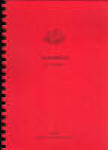 Colin Beech's book "The Redhead", published by The British Society of Australian Philately (1998)
is arguable the most informative publication currently available. It is a essential reference for anyone interested in the history
or the collection of the 1d Reds.
It contains three sections:
Colin Beech's book "The Redhead", published by The British Society of Australian Philately (1998)
is arguable the most informative publication currently available. It is a essential reference for anyone interested in the history
or the collection of the 1d Reds.
It contains three sections:Section 1 includes a brief history, the shade groups, daylight appearance and U-V Light reactions, and periods of use. Section 2 covers forming a shade collection, and details of the various paper & watermark groups. Section 3 includes the Colenso Blogg "Z" prefixed shade list with the corresponding "G" prefix shade numbers. Full detailed information on each "G" shade is provided. Stampboards.com Website Numerous informative posts on all aspects of Stamps can be found on the Stampboards.com website. link | |||||||||||||||||||||||||||||||||||||||||||||||||||||||||||||||||||||||||||||||||||||||||||||||||||||||||||||||||||||||||||||||||||||||||